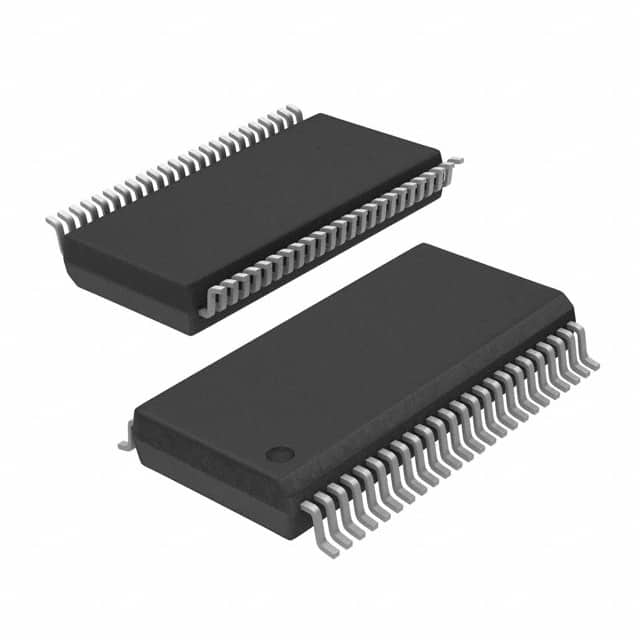Szczegóły produktu można znaleźć w specyfikacjach.

PI74LPT16374CAE
Product Overview
- Category: Integrated Circuit (IC)
- Use: Logic Level Translator
- Characteristics: High-speed, low-power, 16-bit bidirectional voltage level translator
- Package: Ceramic Dual In-Line Package (CDIP)
- Essence: Translates signals between two different voltage levels
- Packaging/Quantity: Available in tubes of 25 units
Specifications
- Number of Bits: 16
- Input Voltage Levels: 2.5V to 5.5V
- Output Voltage Levels: 3.3V to 5.5V
- Maximum Operating Frequency: 100 MHz
- Propagation Delay: 4 ns
- Supply Current: 10 mA
- Operating Temperature Range: -40°C to +85°C
Detailed Pin Configuration
The PI74LPT16374CAE has a total of 48 pins, which are divided into four groups:
- Input Pins (A1-A16): These pins receive the input signals from the lower voltage domain.
- Output Pins (B1-B16): These pins provide the translated output signals to the higher voltage domain.
- Voltage Supply Pins (VCC and GND): These pins provide power supply to the IC.
- Control Pins (OE and DIR): OE (Output Enable) controls the output state, while DIR (Direction) determines the translation direction.
Functional Features
- Bidirectional Voltage Translation: Allows seamless communication between devices operating at different voltage levels.
- High-Speed Operation: Supports data rates up to 100 MHz, enabling fast signal transmission.
- Low Power Consumption: Operates with a low supply current of only 10 mA, making it suitable for battery-powered applications.
- Wide Voltage Range: Compatible with various voltage levels, providing flexibility in system design.
- ESD Protection: Incorporates Electrostatic Discharge (ESD) protection, ensuring robustness against static electricity.
Advantages and Disadvantages
Advantages
- Efficient voltage level translation for mixed-voltage systems.
- High-speed operation enables real-time data transfer.
- Low power consumption prolongs battery life in portable devices.
- Wide voltage range compatibility enhances versatility.
Disadvantages
- Limited to 16-bit translation, may not be suitable for larger data buses.
- Propagation delay of 4 ns may introduce timing issues in certain applications.
- Ceramic Dual In-Line Package (CDIP) may require additional precautions during handling and assembly.
Working Principles
The PI74LPT16374CAE utilizes a combination of MOSFET-based level shifters and control circuitry to achieve bidirectional voltage translation. The input signals are received through the A1-A16 pins and are translated to the higher voltage domain using level shifters. Similarly, the output signals from the higher voltage domain are translated to the lower voltage domain before being provided through the B1-B16 pins. The OE and DIR control pins allow the user to enable/disable the output and select the translation direction.
Detailed Application Field Plans
The PI74LPT16374CAE finds applications in various fields, including:
- Microcontroller Interfacing: Enables communication between microcontrollers operating at different voltage levels.
- Mixed-Voltage Systems: Facilitates data exchange between components with varying voltage requirements, such as sensors, memory modules, and display panels.
- Industrial Automation: Supports voltage level translation in industrial control systems, PLCs (Programmable Logic Controllers), and motor control circuits.
- Consumer Electronics: Used in devices like smartphones, tablets, and gaming consoles to interface components operating at different voltage levels.
Detailed and Complete Alternative Models
- SN74LVC1T45: Single-bit voltage level translator with similar characteristics and package options.
- TXB0108: 8-bit bidirectional voltage level translator with automatic direction sensing.
- PCA9306: Dual bidirectional I2C-bus and SMBus voltage level translator.
These alternative models offer similar functionality and can be considered based on specific application requirements.
Word count: 536 words
Wymień 10 typowych pytań i odpowiedzi związanych z zastosowaniem PI74LPT16374CAE w rozwiązaniach technicznych
Sure! Here are 10 common questions and answers related to the application of PI74LPT16374CAE in technical solutions:
Q: What is PI74LPT16374CAE? A: PI74LPT16374CAE is a type of integrated circuit (IC) that consists of 16-bit D-type flip-flops with 3-state outputs.
Q: What are the key features of PI74LPT16374CAE? A: Some key features of PI74LPT16374CAE include high-speed operation, low power consumption, wide operating voltage range, and 3-state outputs.
Q: How can PI74LPT16374CAE be used in technical solutions? A: PI74LPT16374CAE can be used for various applications such as data storage, data buffering, signal conditioning, and bus interfacing.
Q: What is the maximum operating frequency of PI74LPT16374CAE? A: The maximum operating frequency of PI74LPT16374CAE is typically specified by the manufacturer and can vary, but it is generally in the range of several hundred megahertz.
Q: Can PI74LPT16374CAE be used in both digital and analog circuits? A: No, PI74LPT16374CAE is specifically designed for digital circuits and is not suitable for use in analog applications.
Q: What is the power supply voltage range for PI74LPT16374CAE? A: The power supply voltage range for PI74LPT16374CAE is typically between 4.5V and 5.5V.
Q: Does PI74LPT16374CAE support bidirectional data transfer? A: No, PI74LPT16374CAE is a unidirectional device and supports data transfer in one direction only.
Q: Can PI74LPT16374CAE be cascaded to increase the number of flip-flops? A: Yes, multiple PI74LPT16374CAE ICs can be cascaded together to increase the number of flip-flops as required.
Q: What is the typical propagation delay of PI74LPT16374CAE? A: The typical propagation delay of PI74LPT16374CAE is specified by the manufacturer and can vary, but it is generally in the range of a few nanoseconds.
Q: Are there any specific precautions to consider when using PI74LPT16374CAE? A: It is important to follow the manufacturer's datasheet and guidelines for proper handling, power supply decoupling, and signal integrity considerations when using PI74LPT16374CAE in technical solutions.
Please note that the answers provided here are general and may vary depending on the specific datasheet and manufacturer's specifications for PI74LPT16374CAE.

